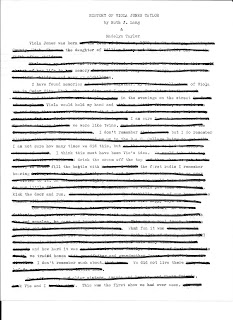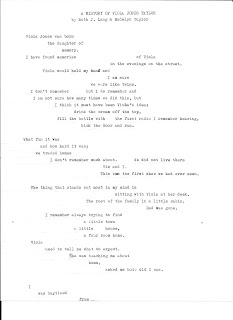An Identity Remix
My grandma Viola was born in 1922, and died long before I
(or my Dad really) could meet her. Last week my younger sister found this
picture of her and shared it with me because we look so similar. exactly like me, but I can still find parts of myself in her
history. The original point of this project was to look at my identity as a
journalist and occasionally a poet; looking at how everything has been written
before; all of art and history is the same stories told over and over and over,
but including my grandma’s history and using the typewriter it has become more
of a commentary, I think, on personal heritages.
I’ve been thinking about her a lot since them, especially since Viola kept journals and Mom always said they helped her through the first few years of marriage. Originally, I wanted to make black out poetry with scanned images from Vie’s journals, but they proved too hard to track down, so I found a history of her written by her sister after she died; I retyped the first three pages (the original manuscript had pictures in it, though it was difficult to read) and tried to tell a story with them. It’s funny that so much of who I am now is dependent on a woman I never knew. I never lived in Utah for more than 2 years before coming to college, but all of her life took place in Utah County, and I can recognize the names of places she lived, including ‘a little town called Lehi’. Viola’s history has racial slurs in it. It mentions her Dad’s ‘Model-T-Ford’ and going to a show before the ‘talkies’ came out. When I’d finished inking out the three pages, I retyped the whole history only with the parts I chose to keep, which I hear is common practice when it comes to history. I know my final product has changed Viola; I know Viola doesn’t look
I’ve been thinking about her a lot since them, especially since Viola kept journals and Mom always said they helped her through the first few years of marriage. Originally, I wanted to make black out poetry with scanned images from Vie’s journals, but they proved too hard to track down, so I found a history of her written by her sister after she died; I retyped the first three pages (the original manuscript had pictures in it, though it was difficult to read) and tried to tell a story with them. It’s funny that so much of who I am now is dependent on a woman I never knew. I never lived in Utah for more than 2 years before coming to college, but all of her life took place in Utah County, and I can recognize the names of places she lived, including ‘a little town called Lehi’. Viola’s history has racial slurs in it. It mentions her Dad’s ‘Model-T-Ford’ and going to a show before the ‘talkies’ came out. When I’d finished inking out the three pages, I retyped the whole history only with the parts I chose to keep, which I hear is common practice when it comes to history. I know my final product has changed Viola; I know Viola doesn’t look
In
Barney’s ‘Responding’ essay, Barney talked a lot about how we re-imagine the
past, and we’re constantly being told that we’re doomed to repeat the past. But
I think ‘doomed’ is a strong term for something that doesn’t have to be
negative. We’re given the same stories as our ancestors were and we have the
opportunity to change them. Looking at the historical representation of
identity, teaching students that they can, and how they can, reinterpret the
way their identities have been portrayed can be an incredibly power tool. We look at what we already have and what we
value and ask ourselves if it still applies, and how it’s changed, and how we
can recreate our media to reflect that shift.






Comments
Post a Comment